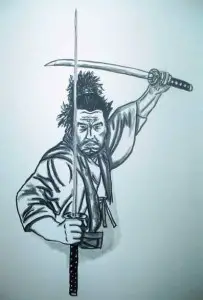 Ashikaga shogunate – a Japanese feudal military regime
Ashikaga shogunate – a Japanese feudal military regime
hakama – loose trousers, a type of traditional Japanese clothing
honor – “To the samurai of this age, the most important thing in the world was honor. As a class, they virtually competed with each other to see who would be the first to die for it. The government had until recently been too busy with its wars to work out an adequate administrative system for a country at peace, and even Kyoto was governed only by a set of loose, makeshift regulations. Still, the emphasis of the warrior class on personal honor was respected by farmers and townsmen alike, and it played a role in preserving peace. A general consensus regarding what constituted honorable behavior, and what did not, made it possible for people to govern themselves even with inadequate laws.” (p.211)
kimono – a Japanese traditional garment worn by women, men and children
Kyohachi Style – style of swordsmanship mastered by Yoshioka Kempō who then modified it to form the Yoshioka style
matsutake – large mushrooms
Nara – “Most people, it seemed, had the impression that the old capital [Nara] was a quiet, peaceful place, where there were lots of colorful temples and tame deer – a place undisturbed by war or famine – but in fact the town was no longer like that at all. After the Battle of Sekigahara, nobody knew how many ronin from the losing side had come to hide there. Most of them were Osaka partisans from the Western Army, samurai who now had no income and little hope of finding another profession. With the Tokugawa shogunate growing in power year by year, it was doubtful whether these fugitives would ever again be able to make a living out in the open with their swords.
According to most estimates, 120,000 to 130,000 samurai had lost their positions. Being the victors, the Tokugawas has confiscated estates representing an annual income of 33 million bushel of rice. Even if the feudal lords who had since been allowed to reestablish themselves on a more modest scale were taken into consideration, at least eighty daimyo, with incomes thought to total 20 million bushel, had been dispossessed. On the basis that for every 500 bushel, three samurai had been cut loose from their moorings and forced into hiding in various provinces and including their families and retainers – the total number could not be less than 100,000.
The area around Nara and Mount Koya was full of temples and therefore difficult for the Tokugawa forces to patrol. By the same token, it was an ideal hiding place, and the fugitives moved there in droves. […]
The old man’s opinion was that it wouldn’t be so bad if it were only these famous ronin hiding out, since they all had a degree of prestige and could make a living for themselves and their families. Complicating the picture, however, were the indigent samurai who prowled the city’s back streets in such straits that they’d sell their swords if they could. Half of them had taken to picking fights, gambling and otherwise disturbing the peace, in the hope that the havoc they caused would make the Osaka forces rise up and take arms. The once tranquil city of Nara had turned into a nest of desperados.” (pp. 254-255)
Noh – a major form of classical Japanese musical drama that has been performed since the 14th century
obi – a sash for traditional Japanese dress
Okuni Kabuki – a kind of dance with words and music invented by a shrine maiden named Okuni at the Izumo Shirine
ronin – a samurai with no lord or master during the feudal period (1185–1868) of Japan
sake – rice wine served slightly warm
samurai – military nobility of pre-industrial Japan
shamisen – a three-stringed traditional Japanese musical instrument
shugyosha – samurais “who wondered about [Japan] devoting their every walking hour to the study of swordsmanship”
Yoshioka dye – a dark brown colour worn by the House of Yoshioka
Publishing details: Musashi – Book 1: The Way of the Samurai by Eiji Yoshikawa, Corgi Books, Translated from the Japanese by Charles S. Terry, Foreword by Edwin O. Reischauer, 1990, 302 p.
